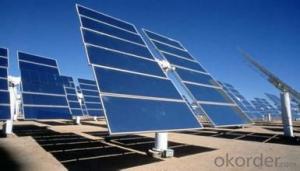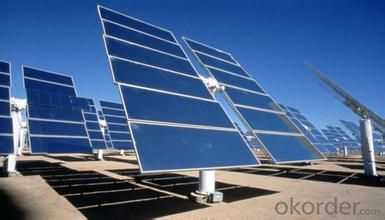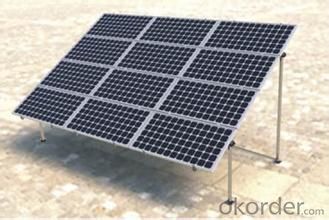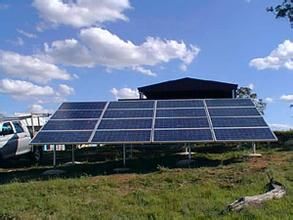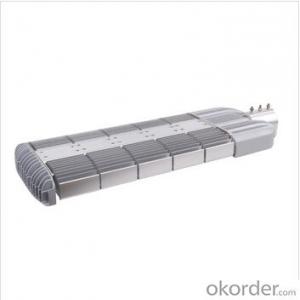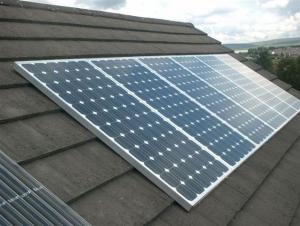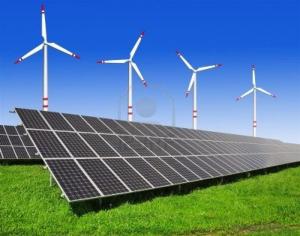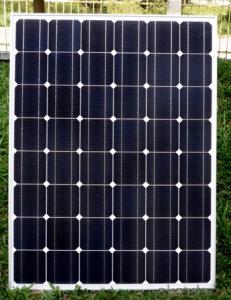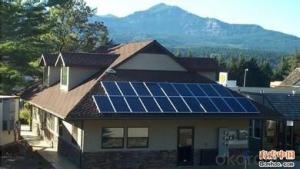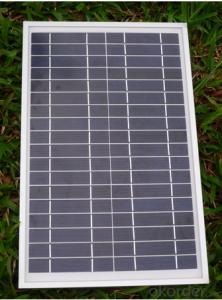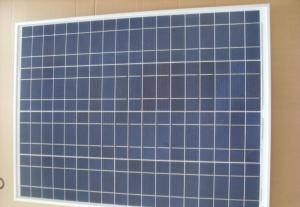40w CNBM Polycrystalline Silicon Solar Panels That Move With The Sun for Home Use
- Loading Port:
- Shanghai
- Payment Terms:
- TT OR LC
- Min Order Qty:
- 100 watt
- Supply Capability:
- 1000 watt/month
OKorder Service Pledge
OKorder Financial Service
You Might Also Like
Specification
40W CNBM Polycrystalline Silicon Panel for Home Using
Production description
Most solar modules are currently produced from crystalline silicon (c-Si) solar cells made of multicrystalline andmonocrystalline silicon. In 2013, crystalline silicon accounted for more than 90 percent of worldwide PV production, while the rest of the overall market is made up of thin-film technologies using cadmium telluride, CIGS and amorphous silicon[7]Emerging, third generation solar technologies use advanced thin-film cells. They produce a relatively high-efficiency conversion for the low cost compared to other solar technologies. Also, high-cost, high-efficiency, and close-packed rectangular multi-junction (MJ) cells are preferably used in solar panels on spacecraft, as they offer the highest ratio of generated power per kilogram lifted into space. MJ-cells are compound semiconductors and made of gallium arsenide (GaAs) and other semiconductor materials. Another emerging PV technology using MJ-cells is concentrator photovoltaics (CPV).
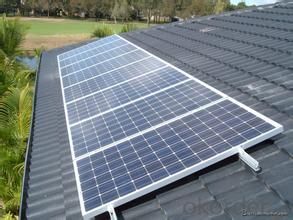
Feature
1.High conversion efficiencies resulting in superior power output performance.
2.Outstanding power output even in low light or high temperature conditions
3.Optimized design for ease of soldering and lamination
4.Long-term stability,reliability and performance
5.Low breakage rate
6.Color uniformaity
Physical characteristic
1. Rigorous quality control meets the highest international standards.
2. High-transmissivity low-iron tempered glass, strong aluminium frame.
3. Using UV-resistant silicon.
4. IS09001/14001/CE/TUV/UL
- Q: I am building a solar panel I have wired in series 36 .5 volt solar cells to produce 8 volts I have another panel that has 34 .5 volt solar cells to produce 7 volts. Any issues with wiring these 2 arrays in Parallel? I.E. would the smaller array take usable power away from the larger array?
- The okorder /
- Q: Can solar panels store excess energy?
- No, solar panels cannot store excess energy.
- Q: Which is more efficient at producing energy? Reference(s) would be nice, but not required.
- Of course solar panels
- Q: Can solar panels be used for outdoor lighting?
- Yes, solar panels can be used for outdoor lighting. Solar-powered outdoor lighting systems capture sunlight during the day and convert it into electricity, which is stored in a battery. This stored energy is then used to power outdoor lights during the night, offering an eco-friendly and cost-effective lighting solution.
- Q: is a wind turbine better than solar panels
- solar water heater and solar power system.
- Q: i have this usb solar panel charger i am building and the solar panel is about 2by .5quot;, so i was wondering if a led light can power it, if so will one be good or would i need more? if so how many?
- While I understand Search's answer, because it was also my first reaction, am I wrong in thinking that this is some sort of science fair project, for which you need to power a solar panel indoors as though it were being illuminated by the Sun? The question at least makes sense in that context. Solar panels provide modest power even from room lighting, sometimes calculators are powered by small panels, but that is a tiny amount of current. . You'll probably do better by asking this question (a bit more clearly) over in Engineering. It's not really an Astronomy Space question, though there may be some crossover between the two groups of users. Meanwhile, while some white LEDs can be pretty dazzling to the eye, I don't know how much actual power they are pulling down compared to what you'll need the panel to generate, but I don't see why it shouldn't work. I just don't know how many LEDs you would need. . .
- Q: Do solar panels work with any type of heat or only sunlight? I have a bunch of little ideas floating around in my head and Id like to get them on paper but only if they really would work.Also does a concentrated amount of heat on one solar panel piece (quot;xor so) produce a higher or equal amount of electricity than a less concentration over a larger area?
- Solar photovoltaics require light, any kind of light. A torch would work, for example. The effect of concentration depends on the amount of light and the material you're shining it on. In CdTe, warmer temperatures and more intense light may lead to better performance. In silicon I think the opposite is true (I don't know though, I've only done research work with CdTe). It depends on properties of the semiconductor, like its band structure. To get an 'order of magnitude' estimate, you may assume a constant efficiency of solar cell so total amount of light (= area * intensity) largely determines the output in standard operating conditions.
- Q: i am working on a project which requires small solar panels. i am looking for ones about 3X4. is there any way i could get these? and where?
- There okorder
- Q: I am starting to think about solar panels as an option for my home. I have done some research on panels, to be honest its all very confusing. There are many different panels some with 60 watts some all the way up to 20 watts. My household currently uses about 2700 to 3400 kWh every two months. So based off of my power usage maybe you can answer some of the following questions:What kind of panels should I be looking at?Which panel manufacturers give the best bang for the buck (reliable/affordable)?Anything else I should be concerned about?I am just starting out in educating myself on solar power so please excuse me if I sound very naive. Any information that you may have will be helpful. Thanks in advance.
- I'm not an expert, but I recently went through the process and now have a system on my home. I got 3 quotes from 3 licensed contractors and they all seemed to be about the same, the prices seemed to be based on the amount of energy they produced. In CA and I'm sure everywhere else they are tested by an independent agency which rates the output of the panels. You seem to have similar usage as my house, I got a 3.75kwhdc unit, it isn't expected to eliminate my bill, but it should reduce it by quite a bit. I've only had it for a few months and it took me from about 45 kwh per day to around 0. I know I'll have lower output in the winter, but my usage is lower in the winter as well. I decided on this size unit to maximize my rebates and I can take advantage of my utilities rebates when I add to the system in a few years. The difference between panels seemed to be how big they were. Some systems can be twice the size and produce the same amount of energy. I put a couple links below that I found helpful. The roseville pv buy down program has some great links that give information about specific systems.
- Q: I am in need of solar panels and the batteries that I can store the energy in. I need to be able to run a laptop, cell phone, and LED lights from it. When I research I see all sorts of options with regards to watts, VMPs, and AMPs. I also see that I may need a controller, an inverter, and various other components. Can anyone help me through these terms and what i need to know in order to efficiently generate and store the electricity. Thanks
- Unlike what most people seem to think, solar panels are not advanced enough to power day to day objects that we use, with the sun that we see in a day. You would need mass amounts of panels and equipment. IF there is a smaller solutions (which I doubt would do what you're asking yet) it would cost thousands of dollars. Panels are not there yet, and the ones that are, are still in development or being guarded from release to the public. The most you'll get out of a few hundred bucks and panels is a lit garden for a few hours at night. Go buy rechargeable batteries.
Send your message to us
40w CNBM Polycrystalline Silicon Solar Panels That Move With The Sun for Home Use
- Loading Port:
- Shanghai
- Payment Terms:
- TT OR LC
- Min Order Qty:
- 100 watt
- Supply Capability:
- 1000 watt/month
OKorder Service Pledge
OKorder Financial Service
Similar products
Hot products
Hot Searches
Related keywords
